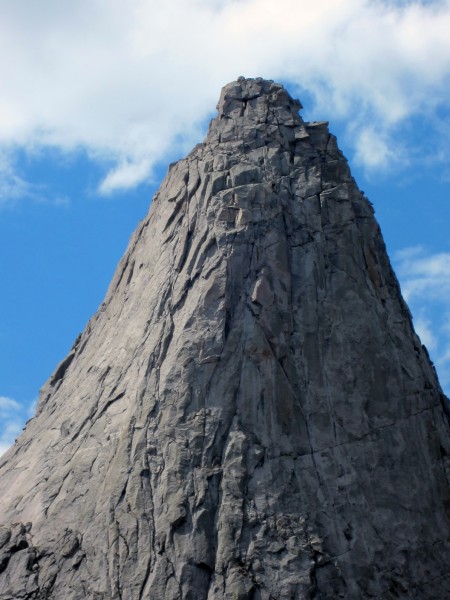Pingora reminds me of a longer, more sustained, more alpine, and overall more difficult climb than the Regular Route of Fairview Dome in California's Tuolumne Meadows. This route ranks among one of my all-time favorite 5.8 climbs. The face, while quite large and intimidating, holds a beauty of a route. The line seems improbable, but weaknesses link together just right to keep the climbing at a moderate grade. The climb also has two distinct characters: lower down the angle is shallower and the cracks are more flared, so it is more friction and face-like climbing at 5.7, but higher up, as the angle increases, the cracks split deeper and cleaner, so the climbing is mostly very nice 5.7 hand and fist jamming.

Visit on googleusercontent.com
Pingora NE Face closeup of the upper part of the route.

Visit on googleusercontent.com
Pingora NE Face

Visit on googleusercontent.com
Pingora NE Face
2012-08-21
After linking the South Buttress of Pingora and Wolf's Head the day before, Thomas and I were eager for more of the great climbing that the Cirque held. The weather was looking better today, so it was on!
Although there were two parties ahead of us, we took our time getting started and although we gained on them, we never quite caught up to them when climbing. Still, we finished the route in only 5.5 hours from the base, leaving plenty of time to enjoy the summit and move our camp down to the lower meadow to be closer to Warrior I and War Bonnet for the following days. This climb had consistently stellar pitches of fairly sustained 5.7 climbing. It is one of the best routes I have done, and every pitch was different and interesting.

Visit on googleusercontent.com
Alpenglow above Cirque Lake.
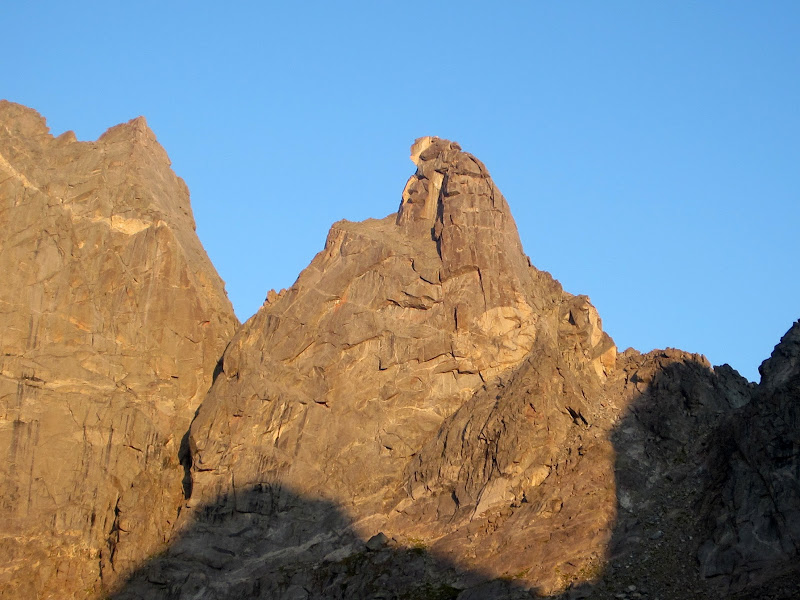
Visit on googleusercontent.com
Alpenglow on Overhanging Tower.
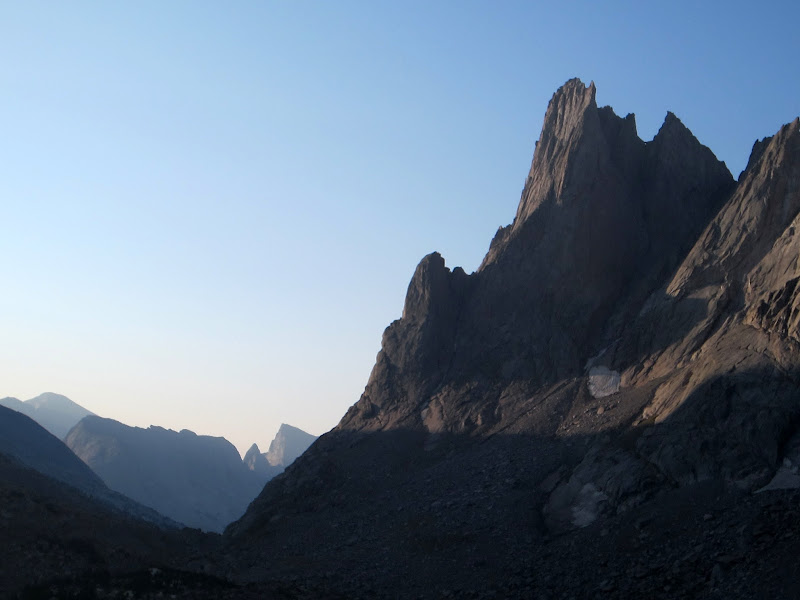
Visit on googleusercontent.com
War Bonnet in the morning.
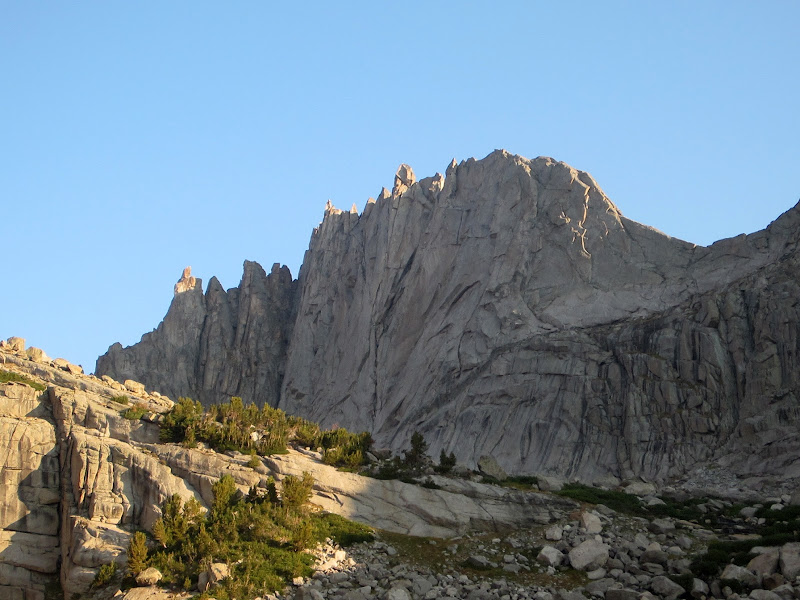
Visit on googleusercontent.com
Wolf's Head in the morning.
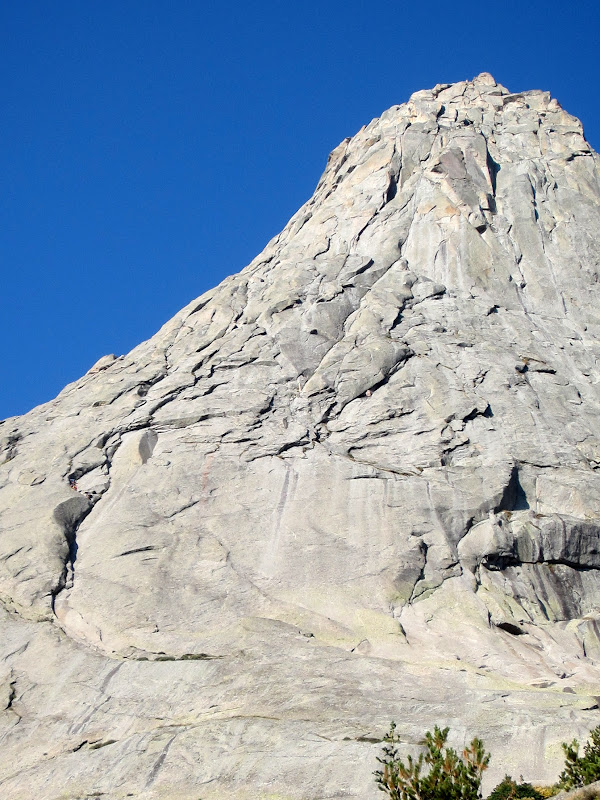
Visit on googleusercontent.com
NE Face of Pingora seen from below.
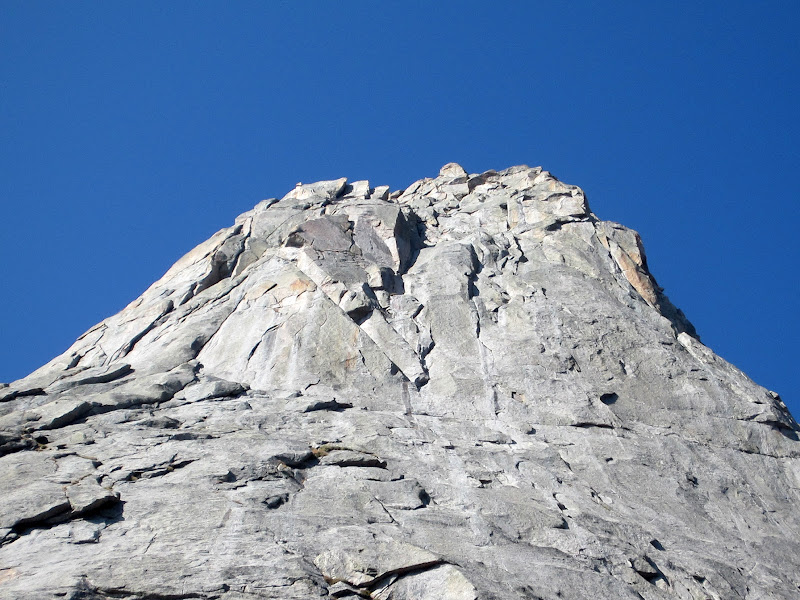
Visit on googleusercontent.com
NE Face of Pingora headwall. The route ascends cracks and chimneys on the left side.
The first pitch is strange in that it has no obvious beginning. Terrain turns into exposed friction slab, so we belayed from there, but simul-climbed to keep the traverse to one pitch. There is one 5.8 friction part, so you want to be belaying before that! If I recall correctly, Thomas had a bit of difficulty leading the 5.8 part until he found that staying a bit lower than one would think was key. After that strange first pitch, the climb picks up fast.
We had only brought one set of cams up to a #4 Camalot, and I suck at liebacks and friction climbing, so I was a bit out of my comfort zone on the first pitch, as it was sustained, but also long so I had to conserve gear. I guess in the end it forced me to climb a little faster instead of fiddling with gear.
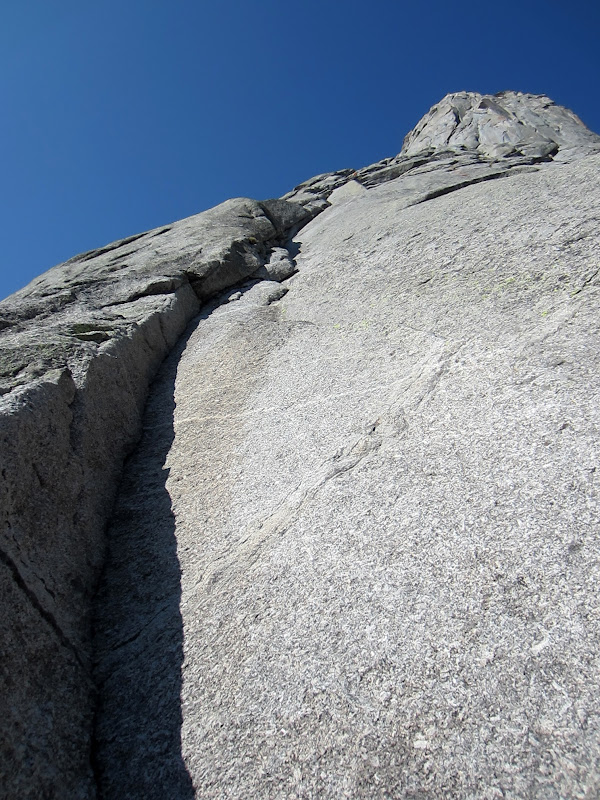
Visit on googleusercontent.com
P2, the most sustained pitch of the route, and pretty long! I had tunnel vision and tried to climb the corner. Don't do that! Climb the face to the left and then step in at the little roof. This corner is slick, steep, and there is no pro in that seam until the stepover.

Visit on googleusercontent.com
Looking up P3 and the fun little roof (5.7).

Visit on googleusercontent.com
P4 5.8 arcing lieback and stem to start. It eases up a lot after turning the corner.
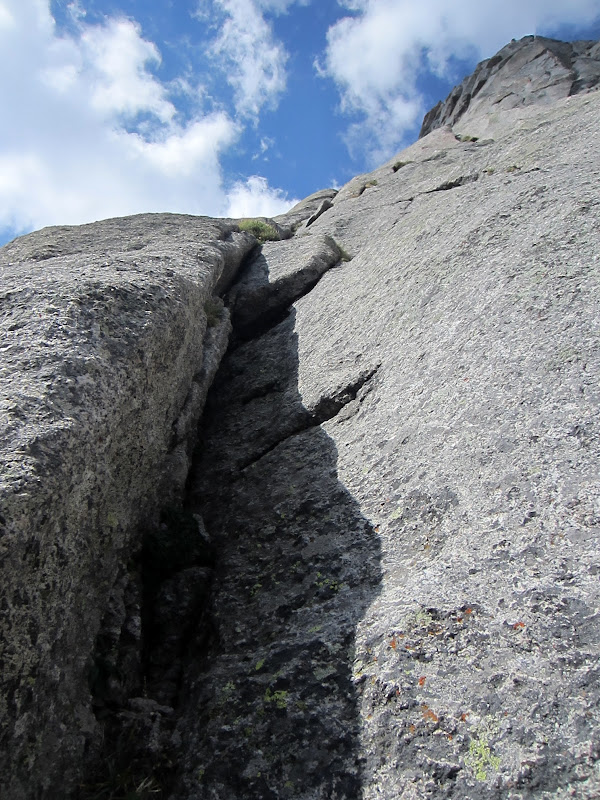
Visit on googleusercontent.com
P4 easier terrain.
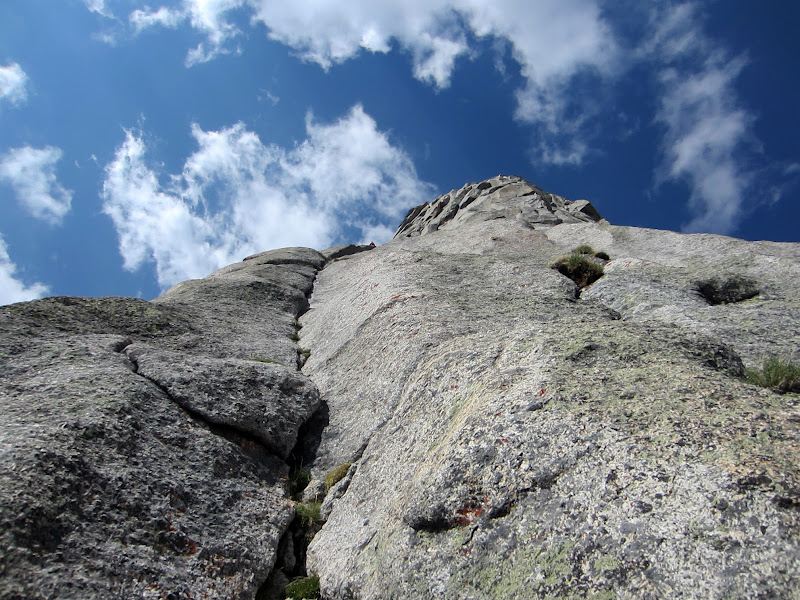
Visit on googleusercontent.com
P5 seam. Not quite as bad as it looks, but you do have limited options for pro and jams.

Visit on googleusercontent.com
Climbers on P7 and P9. As the route got steeper, the climbing got less slabby and the seams opened up to jam cracks, keeping the difficulty remarkably consistent.
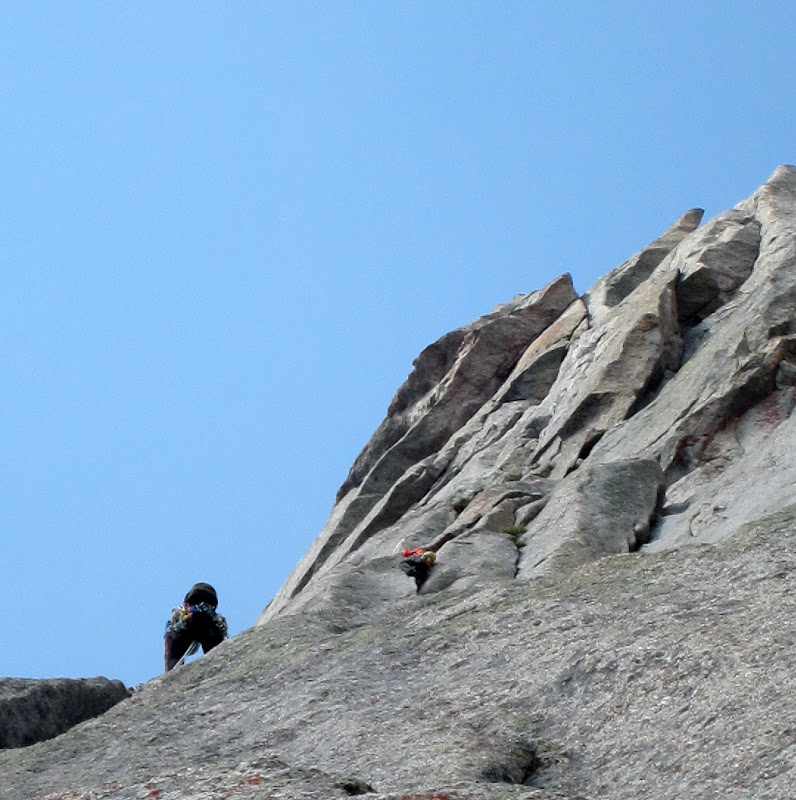
Visit on googleusercontent.com
Climber leading the wide section of P7. Oddly, the #4 cam needed for that pitch protects a lieback at the end. All of the wide climbing was protected by smaller pro.

Visit on googleusercontent.com
Thomas arriving at the P4 belay.

Visit on googleusercontent.com
Warrior I from Pingora.
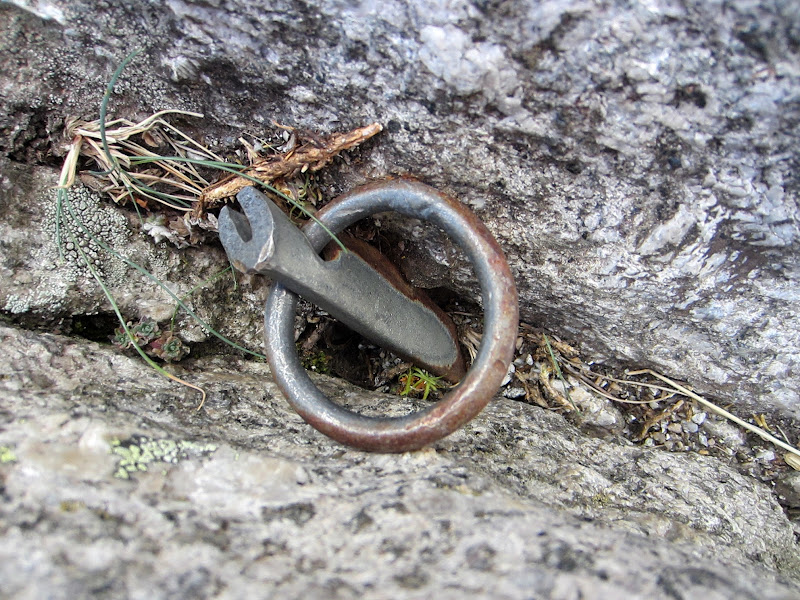
Visit on googleusercontent.com
P5 piton

Visit on googleusercontent.com
P6.5 and P7. Thomas had gone partway into P6, allowing me to make an easy linkup of the rest of P6 and P7. P6 traverses right from here into a corner and to a ledge beneath the 3 corners above. P7 has the 5.8 wide crux of the route and ascends the left of the 3 corners. I think the right corner is the 5.9 lieback variation.

Visit on googleusercontent.com
Finishing P6, just reaching the traverse ledge to the 5.8 wide on P7 (far left crack).
The notorious 5.8 wide wasn't that bad. Really it was more just tight, awkward jamming deep inside the crack as you paste your body into the flare. I was expecting to be pushing the #4 Camalot up with me as I wriggled up the thing, but the crack really only took #1-#3 Camalots . . . until the end, where you flip out into a lieback and make a blind placement with the #4 to protect the last 10 ft.

Visit on googleusercontent.com
P7 wide. Yummy.

Visit on googleusercontent.com
Following P8. The route is definitely getting steeper! More jamming and less friction now.

Visit on googleusercontent.com
P9 5.8 step across. A nice hand crack on the right takes you to a tricky step across to access the left corner. With 70m ropes I linked this with P10 to finish.
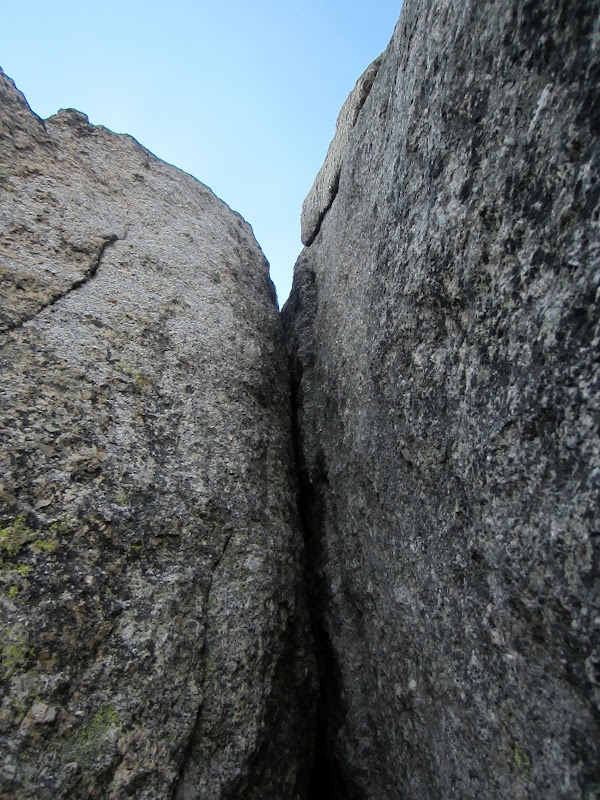
Visit on googleusercontent.com
P10 easy chimney. I'd call it 5.6, but you have to know how to chimney to get that rating! No cheating :-P
I've heard some people call the 'easy chimney' pitch not so easy. I'd call it easy. It just is honest. If you are solid at old school 5.6 Valley chimneys, it is easy. If you aren't . . . well there is some groveling to be had, but the chimney is short and well protected.

Visit on googleusercontent.com
Mitchell Pk from the top of the NE Face.
We could have taken the standard south side rappels, but as we were familiar with the rappels to the Tiger Tower notch where we could supposedly downclimb at cl. 4 directly to our camp, we chose the more familiar line. This time, knowing better, we kept the rappels short, used a EDK, and made much better time down than the day before.
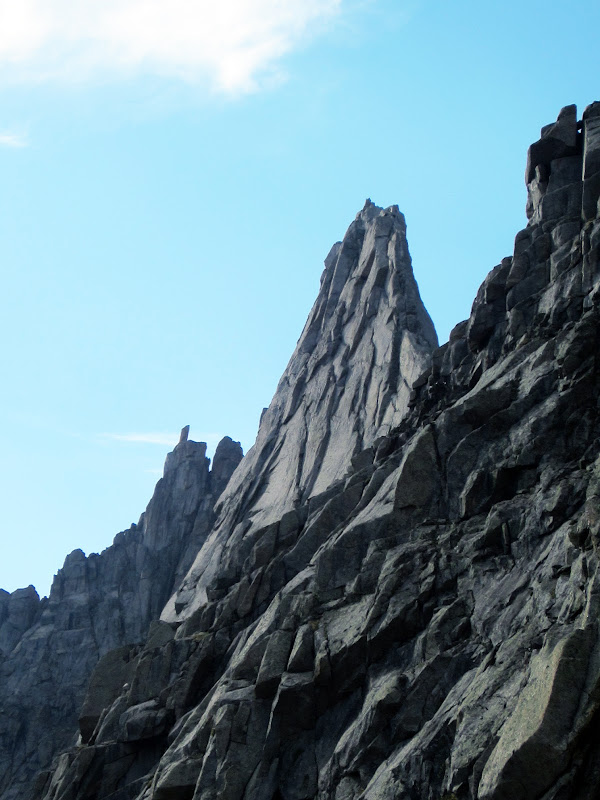
Visit on googleusercontent.com
Wolf's Head seen on the Pingora descent down the gully between Tiger Tower and Pingora.
Downclimbing the gully was interesting because near the end it cliffs out. I don't see how it is cl. 4. Or at least it is easy to take the wrong way down! We traverse out along some promising ledges on the Pingora side of the chute and ended up in some iffy cl. 5 terrain. Once it was apparent that it would only get worse, we rigged a rappel, and with doubles we were able to make it to the ground in one rappel.

Visit on googleusercontent.com
Warrior I seen from the Pingora descent.
2012-08-22
After 3 full days of hiking and climbing, Thomas and I were ready for a break. So we took a rest day and wandered around the cirque for some picturesque views. It was a very relaxed day in a very beautiful place! Even if you have an ambitious climbing plan, I highly recommend leaving aside at least one day to just hike around and enjoy the views.

Visit on googleusercontent.com
Pingora S Side from camp.

Visit on googleusercontent.com
The Watchtower

Visit on googleusercontent.com
Warrior I

Visit on googleusercontent.com
Pingora above Lonesome Lake.

Visit on googleusercontent.com
Cirque of the Towers Panorama. (click to enlarge to give it justice!)
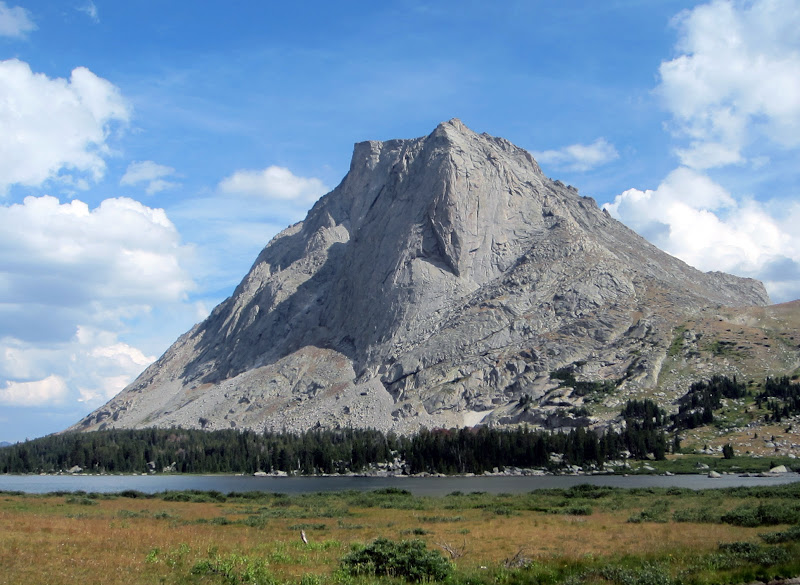
Visit on googleusercontent.com
Mitchell Peak above Lonesome Lake.

Visit on googleusercontent.com
Watchtower to Pingora seen from camp.
We felt VERY solid at the proficiency that we knocked off the South Buttress of Pingora, Wolf's Head, and especially the NE Face of Pingora. While the climbing ratings are definitely stout and old school, it seemed that the grades were light. Because of this, we expected to make short work of the NE Face of War Bonnet the next day, and use our left over energy to go for Fred Beckey's classic 5.9 on Warrior I after. Oops.

Visit on googleusercontent.com
Cirque of the Towers at night. Lights are from climbers descending Wolf's Head and Pingora. Stragglers . . . :-P
Notes:
For rack we just brought 1 set of nuts and one set of cams from #00 C3 to #4 C4 Camalots. This sufficed for all of our climbs in the Cirque, although a double rack to a #2 would make the NE Face of Pingora somewhat more comfortable. The #4 is semi-optional on that climb, depending on your comfort with liebacks.
Just as for any climb in the Rocky Mountains range, expect some amount of afternoon storms and lightning. Start early and aim to be done earlier in the day if you don't want to take chances with safety and success on a route.
As far as bugs, we totally lucked out. Between a dry winter and coming late in the season, there weren't any! Which meant we could enjoy the everpresent Pika squeaks and sublime alpine meadow camps to their fullest. The place was so nice that my last night there I forewent the tent and slept out on a granite slab under the stars.
Personal Website
Photo Album Links:
2012-08-21 - NE Face of Pingora (IV, 5.8, 10P)
2012-08-22 - CoT Rest Day
Other Cirque of the Tower Trip Reports:
South Buttress of Pingora and East Ridge of Wolf's Head Linkup
-
War Path on Warbonnet, NE Face, Left
